
Simon the Sorcerer is a 1993 point-and-click adventure game developed and published by Adventure Soft, for Amiga and MS-DOS. The game's story focuses on a boy named Simon who is transported into a parallel universe of magic and monsters, where he embarks on a mission to become a wizard and rescue another from an evil sorcerer. The game's setting was inspired by the novels of the Discworld series, and incorporates parodies on fantasy novels and fairy tales, such as The Lord of the Rings and Jack and the Beanstalk. The lead character's design was inspired by that of the fictional British television character Blackadder, with the character voiced by Chris Barrie in the CD re-release.
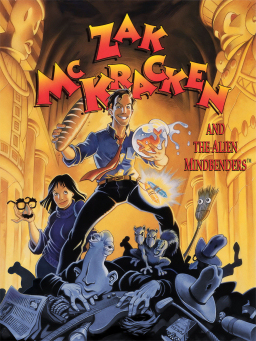
Zak McKracken and the Alien Mindbenders is a 1988 graphic adventure game by Lucasfilm Games. It was the second game to use the SCUMM engine, after Maniac Mansion. The project was led by David Fox, with Matthew Alan Kane as the co-designer and co-programmer.

Star Trek: The Next Generation – A Final Unity is an adventure game by Spectrum HoloByte, based on the Star Trek universe. It was released in 1995 for the DOS and later ported to the Macintosh. It puts the player in control of Captain Picard and his crew of the Enterprise D and features traditional point-and-click adventure gameplay as well as free-form space exploration, diplomatic encounters and tactical ship-to-ship combat.

Interplay Entertainment Corp. is an American video game developer and publisher based in Los Angeles. The company was founded in 1983 as Interplay Productions by developers Brian Fargo, Jay Patel, Troy Worrell, and Rebecca Heineman, as well as investor Chris Wells. As a developer, Interplay is best known as the creator of the Fallout series and as a publisher for the Baldur's Gate and Descent series.

The Gorn are a fictional extraterrestrial humanoid reptilian species in the American science fiction franchise Star Trek. They first appeared in a 1967 episode of the original series, "Arena", in which Captain Kirk fights an unnamed Gorn on a rocky planet. The fight scene has become one of the best-remembered scenes of the original series, in part due to the slow and lumbering movement of the Gorn, which some viewers have considered unintentionally comical.
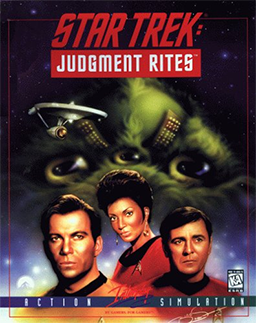
Star Trek: Judgment Rites is a computer game first produced by Interplay Productions in 1993, featuring the original cast of the classic Star Trek in a series of new adventures, including one featuring Trelane, the omnipotent child from the original episode "The Squire of Gothos". Judgment Rites uses the same MS-DOS game engine as the earlier Star Trek: 25th Anniversary; however, it had sharper graphics and sound, particularly with the CD-ROM edition. All of the initial cast members provided voices for their characters on the game in that edition. William Campbell also reprised his guest role as Trelane.
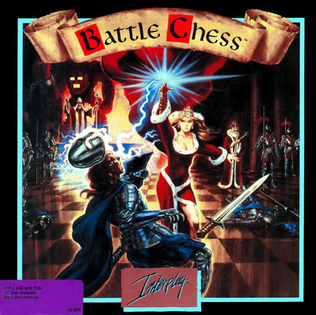
Battle Chess is a video game version of chess with 2.5D graphics and fighting animations showing the result of one piece moving onto the square of another. It was developed and released by Interplay Entertainment for the Amiga in 1988 and ported to many other systems, including the 3DO Interactive Multiplayer, Acorn Archimedes, Amiga CD32, Amiga CDTV, Apple IIGS, Apple II, Atari ST, Commodore 64, MS-DOS, FM Towns, Nintendo Entertainment System, MacOS, PC-98, X68000, and Microsoft Windows. In 1991, Battle Chess Enhanced was released by Interplay for IBM PC compatibles and Macintosh with improved VGA graphics and a symphonic musical score played from the CD-ROM.
The Star Trek franchise has produced a large number of novels, comic books, video games, and other materials, which are generally considered non-canon.

Star Trek: 25th Anniversary is a 1992 adventure video game developed by Interplay and published by Ultra Games for the Nintendo Entertainment System. A different version was made with the same name on the Game Boy.

King's Quest VI: Heir Today, Gone Tomorrow is a point-and-click adventure game, first released in 1992 as the sixth installment in the King's Quest series produced by Sierra On-Line. Written by Roberta Williams and Jane Jensen, King's Quest VI is widely recognized as the high point in the series for its landmark 3D graphic introduction movie and professional voice acting. King's Quest VI was programmed in Sierra's Creative Interpreter and was the last King's Quest game to be released on floppy disk. A CD-ROM version of the game was released in 1993, including more character voices, a slightly different opening movie and more detailed artwork and animation.

Star Trek: Starfleet Academy is a Star Trek PC simulation game developed and published by Interplay in 1997. The game simulates the life of a typical Starfleet cadet, with the player learning the basics of flying a starship and engaging in roleplaying with a crew of cadets, with the eventual goal of becoming captain of their own ship. The game included full motion video featuring William Shatner, Walter Koenig, and George Takei reprising their roles from the original television series and movies, and a multiplayer simulation mode allowing for up to 32 players.

Space Quest IV: Roger Wilco and the Time Rippers is a 1991 graphic adventure game by Sierra On-Line, and the fourth entry in the Space Quest series. The game was released originally on floppy disks on March 4, 1991, and later released on CD-ROM in December 1992 with full speech support; an Atari ST version was announced via Sierra Online's magazine, Sierra News Magazine, but was later canceled. The game sees players assume the role of Roger Wilco, who is thrust into a new adventure across time and space where he must thwart the plans of an old foe that is seeking revenge against him.
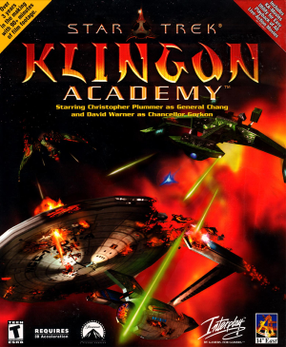
Star Trek: Klingon Academy is a space flight simulator video game developed by 14 Degrees East, an internal development house of publisher Interplay Entertainment. The game follows a young Klingon warrior named Torlek as he attends the Elite Command Academy, a war college created by General Chang to prepare warriors for a future conflict with the United Federation of Planets. Christopher Plummer and David Warner reprised their respective roles as Chang and Gorkon for the production of Klingon Academy.
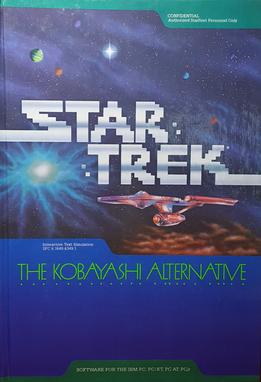
Star Trek: The Kobayashi Alternative was a Star Trek themed computer software game by American studio Micromosaics, designed for the Apple II Plus, Apple IIe, and Apple IIc. The game was also available for the Commodore 64, Macintosh and IBM PC. This text adventure was first published in 1985 by Simon & Schuster. The player assumes the role of Admiral James T. Kirk. As Kirk, the player commands the actions of the Enterprise crew, as well as the Enterprise itself.
Elizabeth T. Danforth is an illustrator, editor, writer, and scenario designer for role-playing games and video games. She has worked in the game industry continuously since the mid 1970s.

Star Trek: The Rebel Universe is an action-adventure computer game published by Firebird Software in Europe and Simon & Schuster Interactive in America. It was originally released for the Atari ST in 1987, and was followed the next year with versions for the Commodore 64 and DOS.

Star Trek: 25th Anniversary is a 1992 Game Boy video game developed by Visual Concepts and published by Ultra, based upon the Star Trek universe. The game chronicles a mission of James T. Kirk and his crew of the USS Enterprise. Despite having the same name, the Game Boy version is not a port of the NES game or computer versions, and is in fact a completely different game. It was succeeded by Star Trek: The Next Generation for Game Boy, developed and published by Absolute Entertainment the following year.

Star Trek: Secret of Vulcan Fury is a cancelled action-adventure game, in development by Interplay Entertainment from 1997 until its cancellation in 1999. Based on the Star Trek: The Original Series license, the game would have followed Captain James T. Kirk and the crew of the USS Enterprise through a series of adventures regarding the Vulcan and Romulan races. Secret of Vulcan Fury was to have been the latest in a series of games produced by Interplay based on the license. It would have featured a control method similar to those seen in LucasArts games of that period, and nearly seven hours of full motion video capture using clay models.
















